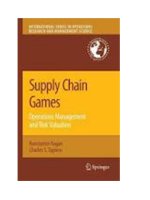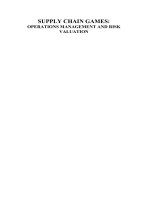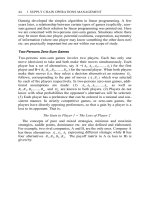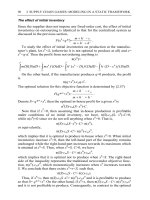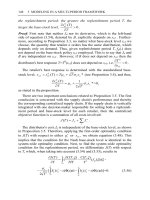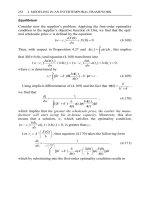Operations management andrews greasley sage course comanions
Bạn đang xem bản rút gọn của tài liệu. Xem và tải ngay bản đầy đủ của tài liệu tại đây (1.16 MB, 177 trang )
SAGE COURSE COMPANIONS
K N O W L E D G E A N D S K I L L S for S U C C E S S
Operations
Management
Andrew Greasley
© Andrew Greasley 2008
First published 2008
Apart from any fair dealing for the purposes of research
or private study, or criticism or review, as permitted
under the Copyright, Designs and Patents Act, 1988, this
publication may be reproduced, stored or transmitted in
any form, or by any means, only with the prior
permission in writing of the publishers, or in the case of
reprographic reproduction, in accordance with the terms
of licences issued by the Copyright Licensing Agency.
Enquiries concerning reproduction outside those terms
should be sent to the publishers.
SAGE Publications Ltd
1 Oliver’s Yard
55 City Road
London EC1Y 1SP
SAGE Publications Inc.
2455 Teller Road
Thousand Oaks, California 91320
SAGE Publications India Pvt Ltd
B 1/I 1 Mohan Cooperative Industrial Area
Mathura Road, New Delhi 110 044
India
SAGE Publications Asia-Pacific Pte Ltd
33 Pekin Street #02-01
Far East Square
Singapore 048763
Library of Congress Control Number: 2006939578
British Library Cataloguing in Publication data
A catalogue record for this book is available from
the British Library
ISBN 978-1-4129-1882-4
ISBN 978-1-4129-1883-1 (pbk)
Typeset by C&M Digitals (P) Ltd, Chennai, India
Printed in Great Britain by The Cromwell Press, Trowbridge, Wiltshire
Printed on paper from sustainable resources
contents
Part One
Introducing your companion
1
Part Two
Core areas of the curriculum
7
Service operations management
Operations strategy
Operations performance objectives
Operations process types
Layout design
Long-term capacity planning
Facility location
Process technologies
Designing products and services
Process design
Job design
Planning and control
Capacity management
Inventory management
Lean Operations and JIT
Enterprise Resource Planning (ERP)
Supply chain management
Project management
Quality
Operations improvement
8
12
18
22
27
31
35
39
45
51
57
61
66
70
76
81
85
90
95
101
2.1
2.2
2.3
2.4
2.5
2.6
2.7
2.8
2.9
2.10
2.11
2.12
2.13
2.14
2.15
2.16
2.17
2.18
2.19
2.20
Part Three
3.1
3.2
3.3
3.4
Study, writing and revision skills
(in collaboration with David McIlroy)
How to get the most out of your lectures
How to make the most of seminars
Essay writing tips
Revision hints and tips
107
108
113
118
128
iv OPERATIONS MANAGEMENT
3.5
3.6
Exam hints and tips
Tips on interpreting essay and exam questions
Glossary
Index
140
150
163
168
part one
introducing your companion
This SAGE Course Companion offers you an insider’s guide into how to
make the most of your undergraduate course, and extend your understanding of key concepts covered in the course. It will provide you with
essential help in revising for your course exams, preparing and writing
course assessment materials, and enhancing and progressing your
knowledge and thinking skills in line with course requirements. It isn’t
intended to replace your textbooks or lectures – it is intended to save
you time when you are revising for your exams or preparing coursework.
Note that RE-vision implies that you looked at the subject the first time
round!
The Companion will help you to anticipate exam questions, and gives
guidelines on what your examiners will be looking for. It should be seen
as a framework in which to organise the subject matter, and to extract
the most important points from your textbooks, lecture notes, and other
learning materials on your course.
This book should direct you to the key issues (and key thinkers) in the
operations management field. Whichever textbook you are using, the
basics are the basics: we have given some guidance on where topics are
covered in specific books, but you should read the Companion in parallel with your textbook and identify where subjects are covered in more
detail in both your text and in your course syllabus.
There is also a study and revision skills guide in Part Three which will
help you to learn more efficiently. Learning is best accomplished by seeing the information from several different angles – which is why you
attend lectures and tutorials, read the textbook, and read around the
subject in general. This book will help you to bring together these different sources.
How to use this book
This book should be used as a supplement to your textbook and lecture
notes. You may want to glance through it quickly, reading it in parallel
with your course syllabus and textbook, and note where each topic is
2 OPERATIONS MANAGEMENT
covered in both the syllabus and this Companion. Ideally, you should
have already bought this book before your course starts, so that you can
get a quick overview of each topic before you go into the lecture – but if
you didn’t do this, all is not lost. The Companion will still be equally
helpful as a revision guide, and as a way of directing you to the key
thinkers and writers on operations management.
The next part of this section provides an introduction to the subject
area of operations management and its relevance to people in organisations. The next section goes into the curriculum in more detail, taking
each topic and providing you with the key elements. Again, this does
not substitute for the deeper coverage you will have had in your lectures
and texts, but it does provide a quick revision guide, or a ‘primer’ to use
before lectures.
You can use this book either to give yourself a head start before you
start studying operations management, in other words give yourself a
preview course, or it can be used as a revision aid, or of course both.
Each section contains within it the following features:
• Tips on handling the infor mation in exams, or r eminders of key issues: these
will help you to anticipate exam questions, and to r emember the main points
to bring in when answering them.
• Examples: These ar e useful for putting the theor y into a ‘r eal-world’ context,
and can of course be used in exams to illustrate the points you make.
• Running themes: the ar eas that will always be of inter est to an operations
manager. You will find that these can almost always be br ought into an exam
question, and you will be expected to do so.
• Input fr om key thinkers in the field: this will be useful to quote in exams, as
well as pr oviding you with the main influences in the development of operations management.
• Sample exam questions with outline answers: these should help you be better pr epared for the actual questions, even though they will (of course) be
different.
• Taking it Fur ther section: this is about taking your thinking a stage beyond simply laying out the cur rent ‘r eceived wisdom’. The T aking it Fur ther section
introduces some criticality , often fr om ‘sharp end’ academic thinking, and will
help you to take a br oader conceptual view of the topic: on a practical level,
this is the type of thinking that moves you fr om a pass to a first!
Part Three of this Companion is a study guide which will help you with
getting more from your lectures, remembering more when you are sitting exams, and with writing essays.
At the back of the book you will find a glossary of the key terms that
are used in the book and an index.
INTRODUCING YOUR COMPANION 3
Introduction to operations management
Operations management is about the management of the processes that
produce or deliver goods and services. Not every organisation will have
a functional department called ‘operations’, but they will all undertake
operations activities because every organisation produces goods and/or
delivers services.
The operations manager will have responsibility for managing the
resources involved in this process. Positions involved in operations have
a variety of names, and may differ between the manufacturing and
service sectors. Examples of job titles involved in manufacturing include
logistics manager and industrial engineer. Examples in the service industry include operations control manager (scheduling flights for an airline), quality manager, hotel manager and retail manager.
People involved in operations participate in a wide variety of decision
areas in an organisation, examples of which are given below:
•
•
•
Service Operations
Management
Operations Strategy
Operations Performance
Objectives
•
Process Types
•
Layout Design
•
Long-term Capacity
Planning
•
Facility Location
•
Process Technologies
•
•
Designing Products
and Services
Process Design
•
Job Design
How do we ensure customers
receive a prompt service?
What strategy should be followed?
How do we measure the
performance of our operations
processes?
How do we configure the process
which will deliver our service to
customers?
How do we organise the physical
layout of our facilities and people?
How do we ensure we have
the correct amount of capacity
available when needed?
What should be the location of
our operations facilities?
What role should technology have
in the transformation of materials
in the operations system?
What products and services
should the organisation provide?
How do we design the service
delivery process?
How do we motivate our employees?
4 OPERATIONS MANAGEMENT
•
•
•
•
•
•
•
•
•
Planning and Control
How do we deploy our
staff day-to-day?
Capacity Management
How do we ensure that our
service is reliably available to
our customers?
Inventory Management
How can we keep track of our
inventory?
Lean Operations and JIT
How do we implement lean
operations?
Enterprise Resource
How do we organise the
Planning
movement of goods across the
supply chain?
Supply Chain Management What benefits could
e-procurement bring to our
operations?
Project Management
How do we ensure our projects
finish on time and within budget?
Quality
How can we implement a
TQM programme?
Operations Improvement
How do we improve our
operations performance over time?
The scale, importance and hopefully the excitement of operations management are indicated by the range of these decision areas. You will find
that most texts on the subject area of operations management are structured around these decision areas, as are the ‘Core areas of the curriculum’ chapters in this text.
Operations management did not emerge as a formal field until the
1950s and 1960s when textbooks specifically dealing with operations
management were published. Major developments up to this point
impacting on the field of operations management start with the Industrial Revolution of the eighteenth century. Before this time products
were made individually by skilled craftspeople in their homes and so
were relatively expensive to produce. The use of inventions such as the
steam engine (by James Watt in England, 1764) and concepts such as the
use of interchangeable parts (Eli Whitney, 1790) and the division of
labour (described by Adam Smith, 1776) led to the move to volume production. Here mechanisation (provided by steam power) was combined
with the use of low-skilled labour (people were given small, simple tasks
using the concept of the division of labour) to produce standard parts in
high volumes which could be assembled into products. These ideas were
INTRODUCING YOUR COMPANION 5
refined by the use of scientific management, developed by Frederick W.
Taylor, who incorporated elements such as time study. The invention of
the moving assembly line (first used by the car manufacturer Henry Ford
in 1913) led to the era of mass production at the start of the twentieth
century. This represented a major breakthrough in the ability of production systems to offer goods to a large number of customers at a price
they could afford.
An additional element in the make-up of operations management
occurred during the Second World War, when a need to solve the complex problems of logistics and weapons-system design led to the development of the area of operations research. A number of the techniques
developed then are still part of the operations management field today.
As stated earlier, operations management as a discipline then began to
emerge in the 1960s and has continued to develop since.
The 1970s saw the use of computers in Materials Requirements Planning (MRP) software for inventory control and scheduling. The 1980s
saw the emergence of the just-in-time (JIT) philosophy from Japan
which transformed the way businesses deliver goods and services. In
response to the need to improve the quality of goods and services, the
ideas of Total Quality Management (TQM) were widely adopted in the
1980s. The 1990s saw the emergence of such concepts as supply chain
management and Business Process Reengineering (BPR). Most recently,
the use of the internet to conduct transactions or e-commerce has
changed the way operations management is performed.
The history of operations shows how the field has adapted and continues to change as it tries to respond to an ever greater range of challenges, from the needs of customers who require high quality low price
goods delivered quickly to managing the impacts of global competition
and addressing environmental concerns.
part two
core areas of the curriculum
The content of operations management is relatively stable, covering the
main areas of design (for example process types), management (for
example JIT operations) and improvement (for example Total Quality
Management). Some of the themes that have become prominent in the
area of operations and which may be incorporated into your assignment
and examination work are outlined below:
1
The r ole of ser vices in operations management: although historically associated with the manufacturing industr y, there has been
a shift in the theor y and practice of operations management to incorporate ser vice systems. This is par tly due to the impor tance of the
ser vice industr y which accounts for an incr easing pr opor tion of the
output of industrialised economies. Section 2
.1 specifically covers
ser vice operations management.
2
The strategic r ole of operations management: despite the ter m
‘operations’, operations management is not simply about the dayto-day ( that is, operational) r unning of an or ganisation. Operations
management does in fact have an impor tant strategic r ole in ensuring that the management of a
n or ganisation’s r esour ces and
processes moves that or ganisation closer to its long-ter
m goals.
Section 2 .2 specifically covers operations strategy .
3
The r ole of technology in operations management:
technology
plays a key r ole in the transfor mation pr ocess which operations
is r esponsible for . Pr ocess technology is used to help transfor m the
three main categories of transfor med r esour ces which ar e materials,
customers and infor mation. Section 2 .8 specifically covers operations technology .
As stated previously, you will find that the area of study in operations
management is quite standardised across different textbooks and curricula. However, because of the wide-ranging nature of the area you
will probably only cover a subset of the topics examined in this
section. The main aspect of the approach to the subject which you
8 CORE AREAS OF THE CURRICULUM
may find is that different academics will devise curricula with varying
amounts of quantitative elements. Thus while there is a general move
towards a qualitative approach adopted in textbooks, and in this revision guide, you may find you need to revise quantitative elements of
the topic such as network analysis, inventory models and linear programming. A good way of getting a feel for the assessment is to try to
obtain past assignments or exam papers. Make sure you check that the
curricula and academic have not changed, however, or you could be in
for a surprise!
Each section below gives a quick overview of the key issues in the
topic with sample exam questions and outline answers. You will
most likely need to expand on these outlines in your exam
responses. Remember, if indicative marks are provided for exam
questions then use them as a guide to the amount of time you
spend on your answers.
2.1
service operations management
Although historically associated with the manufacturing industry, there
has been a shift in the theory and practice of operations management to
incorporate service systems. This is partly due to the importance of the
service industry which accounts for an increasing proportion of the output
of industrialised economies. There is some disagreement about what constitutes the service sector, but in the widest sense it can be seen as organisations that do not fall into what the economists call the ‘primary sector’
(farming, forestry and fishing) or ‘secondary sector’ (industries including
manufacturing, mining and construction). The rise to prominence of the
service sector in the economies of developed countries is due to an increase
in what are termed ‘consumer services’ and ‘producer services’.
Consumer services are services aimed at the final consumers and these
have risen in line with people’s increasing disposable income in developed countries. Once expenditure on essentials such as food and shelter
have been accounted for, people will then spend on purchases such as
travel, hotels, restaurants and other social and personal services.
SERVICE OPERATIONS MANAGEMENT
Producer services are used in the production and delivery of goods
and services and constitute firms providing services such as consultancy
advice, legal advice, IT support, transportation and maintenance facilities. The rise of producer services indicates that although the share of
manufacturing is declining, it still plays an important part in a nation’s
economy. This is because many of the producer services are actually in
business to provide services to manufacturers. Also many of these
services that are being provided were once undertaken by manufacturers themselves and were thus classified as part of the manufacturing
sector!
Types of service operations
In order to assess the challenges for operations in managing services
it is useful to determine the characteristics of different services. You
will find that textbooks differ in how they categorise services. One
classification is that services themselves can be classified by their tangibility, while the way they are delivered can be classified by their
simultaneity.
Tangibility
This is the most commonly used distinction between goods and
services. Goods are tangible, they are a physical thing you can touch. A
service is intangible and can be seen as a process that is activated on
demand. In reality, however, both goods and services have both tangible and intangible elements and can be placed on a continuum ranging
from low to high intangibility.
If goods are tangible, they are a physical thing you can touch. A service is intangible
and can be seen as a process that is activated on demand.
Simultaneity
Simultaneity relates to the characteristic that services are produced and
consumed simultaneously. This means the service provider and
9
10 CORE AREAS OF THE CURRICULUM
customer will interact during the service delivery process. The amount
of interaction is termed the ‘degree of customer contact’. In fact the customer is unlikely to be a passive receiver of the service, but will be
involved to a greater or lesser extent in the actual delivery of the service
itself. For instance, a supermarket requires the customer to choose and
transport the goods around the store and queue at an appropriate checkout till. However, it should not be assumed that all employees in a
service operation have to deal directly with a customer. For the supermarket, the checkout till is an example of high customer contact, but
store personnel may not have to deal directly with the customer at all.
This distinction in services is denoted by ‘back office’ tasks which add
value to the inputs of the service operation (for example stocktaking)
and ‘front office’ tasks which deal with the customer both as an input
and output of the operation.
Simultaneity relates to the characteristic that services are produced and consumed at
the same time.
The fact that services require simultaneity, and are produced and consumed simultaneously, implies another important characteristic of
heterogeneity. This refers to the interaction of the customer, the
service provider and the surroundings causing variability in the performance of the service. From the perspective of the service provider,
humans by their nature are likely to vary their actions and sometimes
make mistakes. Also individual customers will perceive the quality of
the service differently and the context of the service encounter (for
example the existence of queues or weather conditions) may also
impact on the service. This variability in performance and perceptions
may lead to difficulties in maintaining a consistent level of service
quality.
Heterogeneity refers to the interaction of the customer, the service provider and the
surroundings causing variability in the performance of the service.
SERVICE OPERATIONS MANAGEMENT
Taking
it F U R T H E R
Most operations systems produce a mixture of goods and services. Most
goods have some supporting service element (for example a maintenance
contract with a new washing machine), called a ‘facilitating service’, while
many services will have supporting goods (for example a report provided by a
management consultant), termed a ‘facilitating good’.
are the implications of moving tasks between the front office and
“backWhatoffice
areas of a service operation?
”
In order to answer this question you will need to pr ovide a shor t definition of the
terms ‘fr ont of fice’ and ‘back of fice’. For example you could say that ‘back of fice’
tasks add value to the inputs of the ser
vice operation (for example stocktaking)
and ‘front of fice’ tasks deal with the customer both as an input and output of the
operation. Y ou could also note that dif ferent or ganisations will have a dif ferent
balance between fr ont and back of fice operations. In ter ms of moving tasks fr om
back of fice to fr ont of fice some traditional back of
fice-focused or ganisations,
such as manufactur ers, ar e incr easing the r ole of ser vice experience and thus
their fr ont of fice operations. This is because they judge that the ability to dif
fer-
entiate on the ser vice aspect of their of fering may pr ovide a longer-ter m sour ce
of competitive advantage than they can achieve by dif ferentiating with the goods
themselves. In ter ms of moving fr om fr ont of fice to back of fice, some or ganisations ar e r ecognising that customer value is being added by the tangible aspect
of the ser vice package deliver ed by the back of fice operations. For example, budget airlines have eliminated many fr ont-line ser vice aspects of the flight experience and focus on the ‘transpor tation of customer’ pr ocess itself.
“Explain the term ‘heterogeneity’ as applied to the service operations.”
This question r equires you to pr ovide a definition of the ter m ‘heter ogeneity’ and
a discussion of its use in an operations context. Y
as the interaction of the customer
ou could define heter ogeneity
, the ser vice pr ovider and the sur roundings
causing variability in the per formance of the ser vice. Fr om the perspective of the
11
12 CORE AREAS OF THE CURRICULUM
ser vice provider humans by their natur e are likely to var y their actions and sometimes make mistakes. Also individual customers will per
ceive the quality of the
ser vice dif ferently and the context of the ser vice encounter (for example the existence of queues or weather conditions) may also impact on the ser
operations perspective you can say that this variability in per
vice. Fr om an
formance and per-
ceptions may lead to dif ficulties for the operations manager in maintaining a consistent level of ser vice quality . Some ser vices, ter med ‘mass ser vices’, which
operate at high volume and low variety of outcome, attempt to r
educe variability
due to heter ogeneity by standar dising the ser vice. This can be achieved by using
such appr oaches as training staf f to follow standar d procedures and using equipment to suppor t the ser vice deliver y process. This appr oach may not however be
appropriate for pr ofessional ser vices, which operate at low volume and high variety because her e the customer r equires high levels of contact with the ser
vice
provider and a customised ser vice.
Tex t b o o k g u i d e
Chapter 1.
Chapter 5.
SLACK , CHAMBERS AND JOHNSTON : Chapter 1.
GREASLEY :
HILL:
2.2
operations strategy
Operations management includes all the activities that are required to
create or deliver a product or service. Operations engages the majority
of the people employed and assets deployed in most organisations. Thus
the way operations is managed in the long-term, the operations strategy,
is likely to be a vital element of an organisation’s success.
Two generic approaches to operations strategy are the market-based
and resource-based approaches. Using a market-based approach an
organisation makes a decision regarding the markets and the customers
OPERATIONS STRATEGY
within those markets that it intends to target. Along with meeting
customer needs within a market the position the organisation takes in
that market will in part depend on the actions of its competitors. Thus
the organisation’s market position is one in which its performance
enables it to attract customers to its products or services in a more successful manner than its competitors.
A resource-based view of operations strategy works from the insideout of a firm, rather than the outside-in perspective of the market-based
approach. Here an assessment of operations resources and processes
leads to a view of operations capability.
Taking
it F U R T H E R
It has been found that not all companies pursue strategy in accordance with
a purely market-based approach and it has been noted that competitiveness
is not just a matter of simply improving performance along specific competitive dimensions, but incorporates the development of capabilities that provide
specific operating advantages. Thus the resource-based view of strategy is
that operations takes a more active role in providing long-term competitive
advantage.
Operations strategy formulation
Input from Key Thinkers – Terry Hill
One of the most popular approaches to operations strategy formulation is termed ‘the Hill methodology’ (developed by Terry
Hill at London Business School). The emphasis within the Hill
methodology is that strategic decisions cannot be made based on
information regarding customer and marketing opportunities
addressed solely from a marketing function's perspective, but the
operations capability must also be taken into account. Hill proposes that the issue of the degree of 'fit' between the proposed
marketing strategy and the operation's ability to support it is
resolved at the business level in terms of meeting corporate (that
is, strategic) objectives.
13
14 CORE AREAS OF THE CURRICULUM
There are a variety of ways in which operations strategy formulation is
approached in textbooks. Hill provides an iterative framework that links
together the corporate objectives: which supply the organisational direction
and marketing strategy; which define how the organisation will compete in
its chosen markets, and the operations strategy; which provide capability to
compete in those markets. The framework consists of five steps:
1
2
3
4
5
Define corporate objectives.
Deter mine marketing strategies to meet these objectives.
Assess how dif ferent pr oducts win or ders against competitors.
Establish the most appr
products.
opriate mode to deliver these sets of
Provide the infrastr ucture r equired to suppor t operations.
In traditional strategy formulation the outcome of Step 3 is ‘passed on’
to Steps 4 and 5 and no further feedback occurs between steps in the
process. The Hill methodology requires iteration between all five steps
in order to link operations capability into decisions at a corporate level.
Step 3 is the crucial stage in Hill’s methodology where any mismatches between the requirements of the organisation’s strategy and
the operations capability are revealed. This step provides the link
between corporate marketing proposals and the operations processes
and infrastructure necessary to support them. This is achieved by translating the marketing strategy into a range of competitive factors (for
example price, quality, delivery speed) on which the product or service
wins orders. These external competitive factors provide the most important indicator as to the relative importance of the internal operations
performance objectives discussed in Section 2.3 of this book.
Hill distinguishes between the following types of competitive factors
which relate to securing customer orders in the marketplace:
• Order-winning factors: these ar e factors which contribute to winning business
from customers. They ar e key r easons for customers pur chasing the goods or
ser vices and raising the per formance of the or der-winning factor may secur e
more business.
OPERATIONS STRATEGY
• Qualifying factors: these ar e factors which ar e required in or der to be consider ed
for business fr om customers. Per formance of qualifying factors must be at a
cer tain level to gain business fr om customers, but per formance above this
level will not necessarily gain fur ther competitive advantage.
From the descriptions above it can be seen that it is therefore essential
to meet both qualifying and order-winning criteria in order to be considered and then win customer orders.
Step 3 of Hill’s methodology involves providing a ‘fit’ between the
external competitive factors derived from the market position and the
internal performance objectives derived from the operations processes
and resources (infrastructure). Some of the concepts underlining the
idea of how this fit can be achieved are discussed below in terms of the
concepts of trade-offs, focus and agile operations.
Trade-offs
The original idea of trade-offs is that there is a trade-off relationship
between competitive objectives, such as cost, quality, delivery and so on
that means to excel in only one objective usually means poor performance in some or all of the others. Thus an attempt to be good at everything will lead to being mediocre at everything.
There are two basic approaches to managing trade-offs. The first
approach is to manage the trade-off factors within the constraints of the
operations system. This involves ensuring that an operation’s relative
achievement in each dimension of performance should be driven by the
requirements of the market. The second approach is to follow an improvement approach and loosen the constraints on the operations system. This
involves improving the capability of operations to enable improvement in
both dimensions of performance or improvement in one dimension while
preventing or limiting any deterioration in the other.
Focus
The concept of focus is to align particular market demands with individual facilities to reduce the level of complexity generated when
attempting to service a number of different market segments from an
individual organisation. This is because it is difficult and probably inadvisable for operations to try to offer superior performance over competitors across all of the performance objectives (see Section 2.3).
15
16 CORE AREAS OF THE CURRICULUM
The idea of focus has been used by many firms to break up large and
complex organisations into more simple and focused operations.
Although many managers argue that the break-up of organisations leads
to higher costs in terms of duplication of equipment, floor-space and
overheads, many companies have found that focusing has led to a
decrease in operating and overhead costs.
Input from Key Thinkers – Wickham Skinner
Focused operations was first described by Wickham Skinner in 1974.
Based on empirical research, Skinner claimed that a factory that
focuses on a narrow product mix for a particular market niche will
outperform a conventional plant which attempts a broader mission.
Agile operations
The aim of agile operations is to be able to respond quickly to changing
market demand in order to retain current markets and gain a new
market share. Agile operations aims to serve fast changing markets in
which customers demand both high quality service and low cost. Thus
an agile operations strategy aims to overcome trade-offs by developing
the capability of its resources.
“Discuss the main types of flexibility.”
Star t your answer to this question with a definition of flexibility and then explain the
types of flexibility that ar e r elevant to the operations manager . Thus flexibility can
be defined as the ability by an or ganisation to change what it does quickly . This can
mean the ability to of fer a wide variety of pr oducts or ser vices to the customer and
to be able to change these pr oducts or ser vices quickly. Flexibility is needed so the
organisation can adapt to changing customer needs in ter
ms of pr oduct range and
varying demand and can cope with capacity shor tfalls due to equipment br eakdown
or component shor tage. The following types of flexibility can be identified:
• product or ser vice : to be able to quickly act in r esponse to changing customer
needs with new pr oduct or ser vice designs.
• mix : to be able to pr ovide a wide range of pr oducts or ser vices.
OPERATIONS STRATEGY
• volume : to be able to decr ease or incr ease output in r esponse to changes in
demand. V olume flexibility may be needed for seasonal changes in demand.
Ser vices may have to r eact to demand changes minute by minute.
• deliver y: this is the ability to r eact to changes in the timing of a deliver y. This
may involve the ability to change deliver y priorities between or ders and still
deliver on time.
Flexibility can be measured in terms of range (the amount of the
change) and response (the speed of the change). The range and response
dimensions are connected in the sense that the more something is
changed (range) the longer it will take (response). The relationship
between the two can be observed by constructing range-response curves.
In general the benefit of flexibility from the customer’s point of view is
that it speeds up response by being able to adapt to customer needs. The
ability of the internal operation to react to changes will also help maintain dependability (see Section 2.3).
Explain the significance for management of linking operations strategy,
“marketing
strategy and corporate objectives.
”
The key to answering this question is to grasp that the question is asking you to pr
o-
vide an explanation for Hill’s methodology for operations strategy . So explain that the
emphasis within the Hill methodology is that strategic decisions cannot be made
based on infor mation r egarding customer and marketing oppor
tunities addr essed
solely fr om a marketing function’s perspective, but the operations capability must
also be taken into account. Hill pr oposes that the issue of the degr ee of ‘fit’ between
the proposed marketing strategy and the operation’s ability to suppor
at the business level in ter
t it is r esolved
ms of meeting corporate (that is, strategic) objectives.
Thus Hill pr ovides an iterative framework that links together the corporate objectives;
which supply the or ganisational dir ection and marketing strategy; which define how
the or ganisation will compete in its chosen markets, and the operations strategy;
which provide capability to compete in those markets.
Tex t b o o k g u i d e
Chapter 2.
Chapter 2.
SLACK , CHAMBERS AND JOHNSTON : Chapters 2, 3.
GREASLEY :
HILL:
17
18 CORE AREAS OF THE CURRICULUM
2.3
operations performance objectives
In order to ensure that resources are allocated appropriately in operations it is necessary to record, monitor and review aspects of operations
performance. A key task in this process is the identification of appropriate measures of performance that relate to the internal and external
factors that are relevant to organisational competitiveness.
Slack et al. (2007) describe five basic operations performance objectives which allow the organisation to measure its operations performance. The performance objectives are quality, speed, dependability,
flexibility and cost. Each one of these objectives will be discussed in
terms of how they are measured and their significance to organisational
competitiveness.
Quality
From a customer perspective quality characteristics include reliability,
performance and aesthetics. From an operations viewpoint quality is
related to how closely the product or service meets the specification
required by the design, termed the ‘quality of conformance’. The advantages of good quality on competitiveness include:
• Increased dependability: less pr oblems due to poor quality mean a mor e reliable deliver y process.
• Reduced costs: if things ar e done right first time expenditur e is saved on
scrap and cor recting mistakes.
• Improved customer ser vice: a consistently high-quality pr oduct or ser vice will
lead to high customer satisfaction.
Speed
Speed is the time delay between a customer request for a product or
service and the receiving of that product or service. Although the use of
a make-to-stock system may reduce the delivery time as seen by the
OPERATIONS PERFORMANCE OBJECTIVES
customer, it cannot be used for services and has disadvantages associated
with producing for future demand in manufacturing. These include the
risk of the products becoming obsolete, inaccurate forecasting of
demand leading to stock-out or unwanted stock, the cost of any stock in
terms of working capital and the decreased ability to react quickly to
changes in customer requirements.
Thus the advantage of speed is that it can be used to reduce both costs
(by eliminating the costs associated with make-to-stock systems) and
delivery time, leading to better customer service.
Dependability
Dependability refers to consistently meeting a promised delivery time
for a product or service to a customer. Thus an increase in delivery speed
may not lead to customer satisfaction if it is not produced in a consistent manner.
Dependability can be measured by the percentage of customers that
receive a product or service within the delivery time promised.
Dependability leads to better customer service when the customer can
trust that the product or service will be delivered when expected.
Dependability can also lead to lower cost, in that progress checking
and other activities designed to ensure things happen on time can be
reduced within the organisation.
In some instances it may even be important to deliver not too quickly, but only at the
time required (for example a consignment of wet concrete for construction!).
Flexibility
Flexibility is the ability of an organisation to change what it does
quickly. This can mean the ability to offer a wide variety of products or
services to the customer and to be able to change these products or
services quickly. Flexibility is needed so the organisation can adapt to
changing customer needs in terms of product range and varying
demand and can cope with capacity shortfalls due to equipment breakdown or component shortage. The following types of flexibility can be
identified:
19
20 CORE AREAS OF THE CURRICULUM
• product or ser vice : to be able to quickly act in r esponse to changing customer
needs with new pr oduct or ser vice designs.
• mix : to be able to pr ovide a wide range of pr oducts or ser vices.
• volume : to be able to decr ease or incr ease output in r esponse to changes in
demand. V olume flexibility may be needed for seasonal changes in demand.
Ser vices may have to r eact to demand changes minute by minute.
• deliver y: this is the ability to r eact to changes in the timing of a deliver y. This
may involve the ability to change deliver y priorities between or ders and still
deliver on time.
Flexibility can be measured in terms of range (the amount of the
change) and response (the speed of the change). The range and response
dimensions are connected in the sense that the more something is
changed (range) the longer it will take (response). The relationship
between the two can be observed by constructing range-response curves.
In general the benefit of flexibility from the customer’s point of view is
that it speeds up response by being able to adapt to customer needs.
Cost
Cost is considered to be the finance required to obtain the inputs (that
is, transforming and transformed resources) and manage the transformation process which produces finished goods and services.
The major categories of cost are staff, facilities (including overheads) and materials. The
proportion of these costs will differ between operations but averages are staff 15%,
facilities 30% and materials 55%. Thus it can be seen that the greatest scope for reducing cost lies with a reduction in the cost of materials. A relatively small proportion of
costs is usually assigned to direct labour.
If an organisation is competing on price then it is essential that it keeps its
cost base lower than that of the competition. Then it will either make more
profit than its rivals, if the price is equal, or gain market share if the price is
lower. Cost is also important for a strategy of providing a product or service
to a market niche, which competitors cannot provide. Thus cost proximity
(namely to ensure costs are close to the market average) is important to
maximise profits and deter competitors from entering the market.


